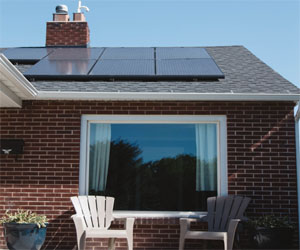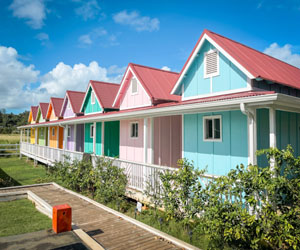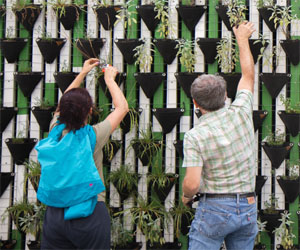


A Glimpse Into Tomorrow's Living Spaces

The concept of the "home of the future" has captured the imagination of generations. From the futuristic visions of the Jetsons to the smart homes of today, our idea of what a home can be is continually evolving. In recent years, the term "home of the future" has taken on new meaning, as technology and innovation have begun to transform our homes into intelligent, connected spaces that enhance our comfort, convenience, and efficiency.
A Symphony Of Automation And Connectivity
The home of the future is a symphony of automation and connectivity. It's a place where technology seamlessly integrates into every aspect of daily life. From the moment you wake up, your home is ready to assist you. Imagine a home where the lights gradually brighten to mimic the natural sunrise, and your coffee maker starts brewing your morning cup as your alarm goes off. This level of automation is now possible thanks to smart home technologies.
Smart Home Upgrades
One of the key elements of the home of the future is the plethora of smart home upgrades available today. These upgrades have revolutionized the way we interact with our living spaces. From intelligent thermostats that adapt to our preferences to security systems that keep a vigilant eye on our property, these technologies hold the potential to elevate our homes into spaces of the future.
Personalized Living
The home of the future is all about personalization. With smart technologies, your home can learn your habits and adapt to your preferences. For example, smart thermostats can create a tailored heating and cooling schedule based on your daily routines. This not only enhances your comfort but also leads to energy savings, making your home more efficient and eco-friendly.
Security And Peace Of Mind
Home security is a top priority for homeowners, and the home of the future takes it to the next level. Smart security systems provide real-time monitoring, allowing you to keep a watchful eye on your property, whether you're at home or away. You can receive alerts on your smartphone if there's any unusual activity, and even remotely control locks, cameras, and alarms.
Efficiency And Sustainability
The home of the future is not only about convenience and security but also about sustainability. Smart homes often incorporate energy-efficient technologies, such as LED lighting, smart appliances, and solar panels. These features not only reduce your environmental footprint but also lower your utility bills.
Voice Control And Automation
Voice-activated systems are becoming increasingly prevalent in the home of the future. You can control your lights, thermostat, music, and more, all with simple voice commands. This level of automation makes everyday tasks easier and more enjoyable.
The Future Is Now
The "home of the future" is no longer a distant dream but a reality for many. With the rapid advancement of technology, smart living spaces are more accessible than ever. Whether you're interested in a few smart upgrades or a fully integrated smart home, the possibilities are endless.
The home of the future is a testament to human ingenuity and innovation. It's a place where technology enhances our lives in remarkable ways, from automating daily tasks to providing security and sustainability. As we continue to embrace smart living, our homes will evolve, providing us with greater comfort, convenience, and efficiency than ever before. The future is now, and it's time to make our homes smarter and more connected than ever.






Innovations For A Sustainable Future
 Efficiency: Efficient water use is not only environmentally responsible but also financially advantageous, as it leads to cost savings for individuals, businesses, and communities.
Efficiency: Efficient water use is not only environmentally responsible but also financially advantageous, as it leads to cost savings for individuals, businesses, and communities.
Water-Saving Technologies And Innovations
Low-Flow Fixtures: Low-flow faucets, showerheads, and toilets use innovative design and technology to reduce water consumption without sacrificing performance. These fixtures limit water flow while maintaining water pressure.
Smart Irrigation Systems: Advanced irrigation technologies use sensors and data analysis to optimize watering schedules and ensure that landscapes receive the right amount of water. This reduces water wastage from over-irrigation.
Shaping Spaces For Comfort And Functionality
 Functional Layout: An effective housing design starts with a well-thought-out floor plan. It considers the practical needs of residents, from the number of bedrooms and bathrooms to the placement of the kitchen and living areas. An efficient layout maximizes space utilization and minimizes wasted square footage.
Functional Layout: An effective housing design starts with a well-thought-out floor plan. It considers the practical needs of residents, from the number of bedrooms and bathrooms to the placement of the kitchen and living areas. An efficient layout maximizes space utilization and minimizes wasted square footage.
Aesthetics: While functionality is paramount, aesthetics are equally important. Aesthetically pleasing design can enhance the quality of life for residents. The choice of materials, colors, and architectural elements can create a sense of comfort, style, and identity within the home.
Sustainability: Sustainable housing design is on the rise, driven by a growing awareness of environmental concerns. Green building practices focus on using eco-friendly materials, energy-efficient technologies, and renewable energy sources to minimize the carbon footprint of a home.
Adaptability: Housing design should be flexible and adaptable to accommodate the changing needs of its inhabitants. This is particularly important in a world where the dynamics of families and lifestyles evolve over time. Features like convertible spaces and modular furniture are becoming more popular.
Accessibility: Accessibility is a critical aspect of housing design. It ensures that homes can be comfortably and safely used by people of all ages and abilities. Features like wider doorways, no-step entries, and accessible bathroom and kitchen designs are integral to inclusive housing.
Natural Light And Ventilation: Designers are increasingly focusing on maximizing natural light and ventilation in homes. Well-placed windows and open floor plans can significantly improve the quality of life for residents while reducing the need for artificial lighting and climate control.
Exploring The Benefits Of Solar Energy
 2. Reduced Electricity Bills
2. Reduced Electricity Bills
Solar panels allow homeowners and businesses to generate their electricity, which can lead to substantial cost savings on their electricity bills. By producing your electricity, you can significantly reduce or even eliminate your reliance on traditional utility providers.
3. Energy Independence
With solar panels on your roof or property, you gain a degree of energy independence. You are less reliant on the grid, which can be especially advantageous during power outages. Solar power systems, combined with energy storage solutions like batteries, can provide a consistent supply of electricity even when the sun isn't shining.
4. Increased Property Value
Homes and commercial properties equipped with solar panels often see an increase in their market value. Solar panels are viewed as attractive assets, and many potential buyers are willing to pay a premium for a property with solar installations.
5. Government Incentives
Many governments worldwide offer incentives, tax credits, and rebates to encourage the adoption of solar energy. These financial perks can make solar installations more accessible and affordable for homeowners and businesses.
6. Low Operating Costs
Once installed, solar panels have minimal operating and maintenance costs. Regular cleaning and occasional inspections are usually all that's needed to keep the system running efficiently.
Embracing Minimalism For A More Fulfilling Life
 4. Quality Over Quantity
4. Quality Over Quantity
In a world where we are often encouraged to buy more for less, minimalism emphasizes the importance of quality over quantity. Instead of opting for numerous inexpensive items, invest in high-quality products that are built to last. This not only reduces waste but also leads to a more cost-effective and satisfying life in the long run.
5. Mindful Consumption
Minimalism promotes mindful consumption. Before making a purchase, think about whether the item aligns with your values and needs. Consider whether it will enhance your life or merely contribute to clutter. Being mindful of what you bring into your life can lead to more intentional and fulfilling choices.
6. Reduced Environmental Impact
By living with less and consuming mindfully, minimalism can have a positive impact on the environment. Reducing waste, conserving resources, and making eco-friendly choices are intrinsic to this way of life, which ultimately contributes to a more sustainable planet.
Protecting Our Planet Through Sustainable Practices
 Environmental benefits are critical for several reasons:
Environmental benefits are critical for several reasons:
Ecosystem Health: By reducing pollution, habitat destruction, and resource depletion, environmental benefits help maintain the health and diversity of ecosystems.
Climate Change Mitigation: Sustainable practices that reduce greenhouse gas emissions and promote carbon sequestration are essential for combating climate change.
Resource Conservation: Environmental benefits help protect and conserve vital resources like water, soil, and biodiversity.
Human Health: A cleaner environment means better air and water quality, which directly affects human health.
Strategies For Achieving Environmental Benefits
Numerous strategies and practices contribute to environmental benefits:
Renewable Energy: Transitioning to renewable energy sources like solar, wind, and hydropower reduces greenhouse gas emissions and lessens the environmental impact of energy production.
Waste Reduction: Reducing, reusing, and recycling materials minimizes waste and lowers the environmental footprint of resource extraction and disposal.
Sustainable Agriculture: Practices like organic farming, crop rotation, and agroforestry help maintain soil health, reduce chemical use, and preserve biodiversity.
Green Building Design: Energy-efficient and sustainable building designs can lower energy consumption and minimize the use of natural resources.
Conservation And Restoration: Protecting and restoring natural habitats can preserve biodiversity, improve water quality, and sequester carbon.
Cultivating A Sustainable Green Space
 Benefits Of Eco-Friendly Gardening:
Benefits Of Eco-Friendly Gardening:
Reduced Environmental Impact: One of the primary advantages of eco-friendly gardening is its ability to reduce the negative impact on the environment. By avoiding harmful chemical pesticides and synthetic fertilizers, you help protect the soil, water, and air from pollution.
Biodiversity: Eco-friendly gardening practices encourage the presence of diverse plant and animal species in your garden. This not only adds to the beauty of your green space but also contributes to local biodiversity and ecosystem health.
Sustainability: Sustainable gardening prioritizes renewable resources and practices, ensuring the long-term health and productivity of your garden. Composting, mulching, and water conservation are key elements of this approach.
Healthier Garden: By avoiding harsh chemicals, your garden becomes a healthier place for plants, insects, and people. Organic gardening methods promote the use of natural predators to control pests, resulting in a balanced and thriving ecosystem.
Cost-Effective: Eco-friendly gardening can be cost-effective in the long run. While initial investments in organic soil amendments and composting may be slightly higher, the reduced need for chemical inputs and lower maintenance costs can offset these expenses over time.
Principles Of Eco-Friendly Gardening:
Natural Pest Control: Encourage beneficial insects like ladybugs and lacewings, and use natural remedies like neem oil to combat garden pests.
Organic Soil Enrichment: Improve soil health with compost and organic matter, reducing the need for synthetic fertilizers.
From Neglect To Paradise
 Assessment And Planning: The first step in any garden transformation is a thorough assessment of your space. Take a critical look at your garden, considering factors such as the current state of the plants, soil quality, layout, and potential issues like drainage problems. This assessment will help you identify the areas that need the most attention and guide your planning.
Assessment And Planning: The first step in any garden transformation is a thorough assessment of your space. Take a critical look at your garden, considering factors such as the current state of the plants, soil quality, layout, and potential issues like drainage problems. This assessment will help you identify the areas that need the most attention and guide your planning.
Clearing And Cleaning: For many neglected gardens, the first order of business is clearing away overgrown vegetation, weeds, and debris. This is the blank canvas upon which your transformation will unfold. Prune unruly branches, remove dead plants, and clear the ground to prepare it for new growth.
Soil Improvement: Healthy soil is the foundation of any successful garden. Assess your soil's condition and amend it as necessary. Adding organic matter like compost or well-rotted manure can improve soil structure and fertility, ensuring your plants have the nutrients they need to thrive.
Plant Selection: Choose plants that are well-suited to your local climate and growing conditions. Consider a mix of annuals, perennials, shrubs, and trees for a balanced and visually appealing garden. You can also incorporate native plants, which are adapted to the area and require less maintenance.
Garden Layout And Design: Carefully plan the layout of your garden. Consider elements like pathways, seating areas, and focal points. Create a design that not only enhances the beauty of your space but also ensures practicality and ease of maintenance.
Hardscape Elements: Incorporate hardscape elements like stone pathways, decorative walls, or patios to add structure and functionality to your garden. These features can create focal points and define different areas within the garden.